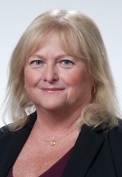“How are babies made?”
That may be a question to give any parent of a five-year-old palpitations on the spot. However, after lectures about the emerging technologies surrounding in vitro fertilization, surrogacy, and reproductive medicine, I realized the answer may not be as clear as we have thought in the past. To learn more about the processes and delve into the unique ethical issues involved in the field, I spoke with our own UA College of Medicine – Phoenix specialist in reproductive endocrinology and infertility, Dr. Linda Nelson, who has practiced for over 25 years in the field.
 Alex: First off, thank you for taking the time to talk about this!
Alex: First off, thank you for taking the time to talk about this!
Dr. Linda Nelson: Of course, whatever I can do to help. It’s a fascinating field, and I’m happy to expand upon any topics. To start, I can recommend that the American Society for Reproductive Medicine (ASRM) has great guidelines for different ethics scenarios.
Alex: Briefly, what methods are available to patients who need assistance having children?
Dr. Linda Nelson: There are many different technologies we can use today. We first assess the couple with fertility studies, which include semen analysis, hormonal panels, and imaging of the uterus and ovaries. The hormonal tests evaluate ovulation and ovarian reserve. Most women will take rounds of fertility hormones (Clomid or gonadotropins) to induce endogenous release of oocytes. If needed, the couple can proceed to in vitro fertilization (IVF). With in vitro fertilization, there is a transvaginal ovum retrieval from the follicles and embryo transfer into the uterus. Also included are methods of intracytoplasmic sperm injection, cytoplasmic transfer, cryopreservation of ovarian follicles, and sperm and egg donation, all with varying levels of success. There is also the option of pre-implantation genetic diagnosis (PGD), which opens the door to the controversial option of sex selection since the genetic analysis of the embryo includes the determination of XX or XY.
Alex: Speaking of egg and sperm donors, how does third-party involvement change the dynamic?
Dr. Linda Nelson: This is generally referred to as third-party reproduction. Couples can recruit their own individual as a sperm or egg donor or as a surrogate or gestational carrier. One potential complication is that sometimes people can involve family members, which then can create a situation where an older mother may try to use her daughter’s eggs to conceive with her new partner, thereby making the child a biological “granddaughter.” Additionally, the daughter could carry the biological child of the mother and the new partner as a gestational carrier. Laws surrounding surrogacy and gestational carriers vary from state to state and are more formalized in California.
Another complication is the coercive possibility with donation of money transfers, particularly with egg donation. The ASRM recommends that donors are compensated a “reasonable amount” for their time and donation; however, a reasonable amount is not always standard. There is concern that donors are from lower socioeconomic groups or may be exploited for these procedures. Infertility specialists also worry about the practices of egg sharing. In this process, a woman who wants to pursue assistive technologies but cannot afford it alone would have her eggs harvested, and [she would then] donate half of those as donor eggs for someone else to have the option of an IVF cycle for her own conception.
Egg and sperm donors can advertise unique characteristics that may be needed for a couple. For example, a donor could advertise he/she was Asian, which could be of importance as most sperm banks have limited pools of diverse donors. Any noted history of later discovered cancer or genetic disease would remove the samples from the sperm pool or donor pool.
Alex: What does your patient population look like?
Dr. Linda Nelson: We see many different types of patients in clinics I’ve worked with over the years. There are married couples where either the man or woman is infertile, single women choosing to have a child, young professionals who freeze their eggs, and LGBTQ couples. Practitioners who may elect to not treat single women or LGBTQ couples on personal ethical grounds are recommended by the ASRM to list this choice before patients seeking assistance start the process with that physician. We also see a wide variety of patients from various socioeconomic and cultural backgrounds, including patients in the Community Health Center (CHC) at Maricopa Medical Center.
Alex: How do you approach fertility methods for younger patients, such as those undergoing chemo, who may not have their reproductive life plan determined yet?
Dr. Linda Nelson: For those that have reached puberty, we discuss harvesting and freezing eggs/sperm for patients. We always try to provide the option of fertility later in life, just as we would for adults. Methods for pre-pubescent cancer patients are more limited and experimental, such as ovarian tissue cryopreservation, but are offered to females who are at high risk for premature ovarian failure due chemotherapy treatments.
Alex: In cases where a couple creates embryos, what issues arise with storage over time and after the couple is “done” having children?
Dr. Linda Nelson: Usually when a couple elects to do IVF, the couple will fill out a form denoting their wishes between options regarding the disposition of their embryos after formation: destruction, donation to medical research, use by the surviving partner in case of separation, or donation to another couple (to assist having a child). Many times, couples choose to donate to other couples at the start but will then change their mind after their first [assisted] child. Parents will feel uncomfortable with the idea of having their potential offspring existing in the world without their knowledge. This is another example of the difficult choices that infertility patients often need to make as they travel in their journey to parenthood using ART.
Alex: What issues arise if the couple splits, and how is that normally handled?
Dr. Linda Nelson: After the child is conceived, the case is no different [regarding that child] in comparison to a natural conception. However, the fate of any cryopreserved embryos is often subject of disagreement by the couple. In general, patients would need to obtain legal permission to use the embryos, and often these cases end up as high-profile matters in the press.
Alex: What effects might legislation have upon fertility clinics?
Dr. Linda Nelson: ASRM has a staff member who is a liaison for government issues. That person monitors the running legislation that could affect practices. There is a risk that legislature related to the definition of personhood could reduce the ability to use these technologies though the hope and intention is that this would not limit people’s abilities to have children. What more often affects the practice is that technology outpaces what dilemmas we can face. We as scientists and always want to do the best for our patients; however, the cultural and societal implications for what we advance are not always determined as quickly. By working closely with our colleagues within the ethical, legal, and mental health arenas, hopefully we can approach our new technologies in a comprehensive manner to help our diverse patients make the best choices for them and to build happy, healthy families.
For more information, please check out the website for the American Society for Reproductive Medicine: http://www.asrm.org/news-and-publications/ethics-committee-documents/
Alexandra Cooke is a medical student at The University of Arizona College of Medicine – Phoenix. She graduated in 2013 from UA with bachelor's degrees in physiology and international studies. This self-proclaimed global health nerd and news junkie can commonly be found downtown exploring local coffee shops and bookstores or out dancing ballroom or swing with friends. In the future, Alexandra hopes to incorporate her passions (somehow) into her medical career and be able to empower patients. She is one of the co-chairs of the Medical Ethics Interest Group.


